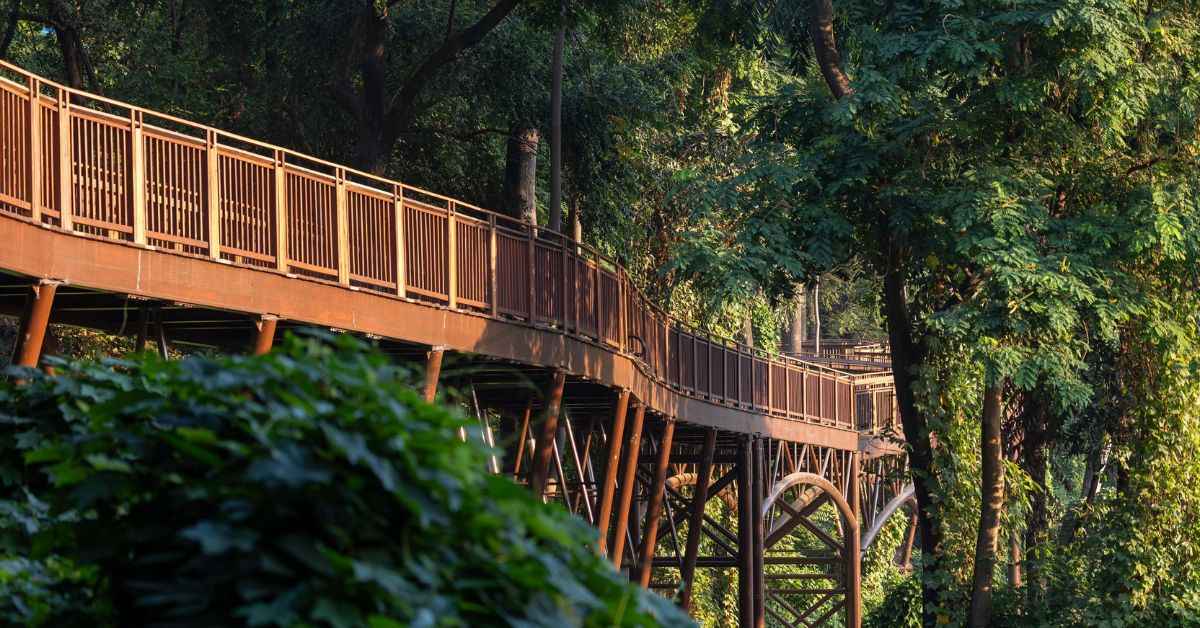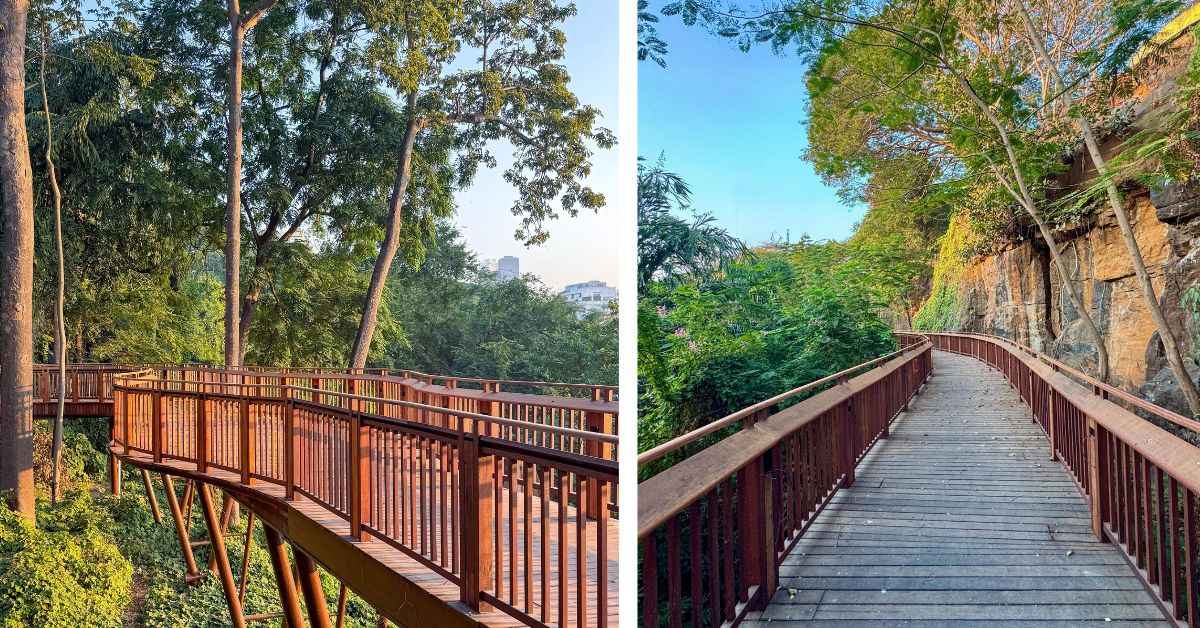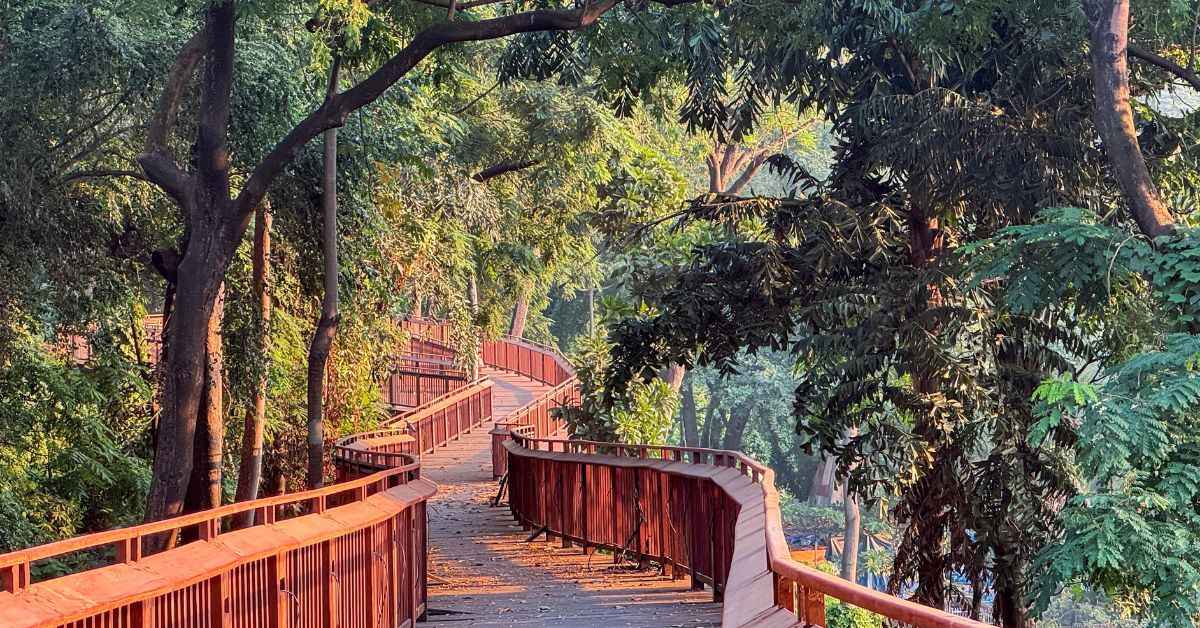A Behind-The-Scenes Walk With the Architect Who Designed Mumbai’s Malabar Nature Trail
15 April 2025, 7:50 am
I’m at the nature trail in Mumbai’s Malabar Hill, here to meet a certain someone. My wait gives me a front-row seat to several conversations playing out simultaneously. The 100-odd people slotted into the same time frame as me are a chatty bunch, I conclude.
I can’t help smiling to myself as a sibling duo (evidently quite sleepy) whine about the early time slot. Their father pacifies them, “Aise subah mein ghumna kabhi hota hai? (Where do we get morning outings otherwise?).” A cogent argument, I agree.
A posse of women chat animatedly, visibly excited by this “unlikely” spot. I share their awe; the walkway is a mood board of beautiful views. Besides them, an elderly uncle duo laughs heartily. Just as I’m about to discover the joke, the certain someone I’ve been waiting for taps me on the shoulder. Rahul Kadri is here.
Until today, I knew Rahul as one of the principal architects of IMK Architects — an architectural firm whose expertise dates back to 1957; their projects dominate the Indian skyline, functionality and culture convening in each. But, from 30 March 2025 onwards — the day the walkway was opened to the public — I will recognise Rahul as the man who gifted Mumbai a time portal into the past.
The architect unravels the art
It’s barely a month since the Malabar nature trail gained a place in the city’s memory. But it hardly feels like a newcomer. It’s almost as if the trail always existed and just needed to be uncovered.
We amble along the walkway, guided by its contours and dips. Rahul, on the other hand, relies on muscle memory to find his way. After all, he forged these very trails as a child when he’d explore the forest with his pet dog.
 The Malabar Hill walkway is constructed in a way that there is no disruption to the flora and fauna of nature here
The Malabar Hill walkway is constructed in a way that there is no disruption to the flora and fauna of nature here
Then, decades later, he did it again, while supervising the construction of the walkway. This project is a collaborative effort by the Nepean Sea Road Citizens’ Forum (NRCF) and IMK Architects, with support from the JSW Foundation and funding from the Brihanmumbai Municipal Corporation (BMC). “I’ve watched it [the walkway] come up little by little. Seeing it in its present form is a dream come true,” Rahul explains.
We’re shaded by a canvas of green that dances above our heads. The forest is an archive of gulmohar, copperpod, mango, coconut, rain tree, jamun, and jackfruit trees. Our company is audio-visual; while the trees make for a pretty sight, the chirp of birds cracks into the silent interludes during our walk.
Rahul’s design mastery doesn’t come as a surprise. He is following in the footsteps of a fabled architectural legacy. His father, Iftikhar Kadri — now 97 — gave Mumbai its beloved Nehru Centre, a living memorial to India’s first Prime Minister, Jawaharlal Nehru.
As Iftikhar had mentioned in an interview, the design was born out of wanting it to reflect the former prime minister’s ideals, with the building’s cylindrical shape portraying a nation reaching up towards the sky and its cross latticework alluding to the whorls of the rose flower that Nehru always wore in his lapel.
Like his father, Rahul’s genius lies in architecting places that are rich with possibilities. His architectural vocabulary is angled towards simplistic design that aces functionality. He reasons, “The design needed to be simple; I wanted people to experience the forest and its views. I did not want the structure to be too intrusive within the forest.” I agree, the walkway cuts through the forest with finesse, almost like a way of hope through the urban sprawl that skirts around its perimeter.
Rahul adds, “No trees were cut for the project.” The walkway has found its safe space, its Merbau wood torso supported by epoxy-coated steel columns, cradled by the land, almost like a huge hammock that finds support in the forest’s beams.
Our walk is punctuated by nameplates that bear mention of the different species of birds that call this forest home — the Great Indian Hornbill, bulbuls, and parakeets. The walk boasts pockets of unprecedented stillness, broken only by the sounds of nature.
‘Came here as a boy of 11 years’
“Are you the architect who built this?”
“Are you Rahul Kadri?”
“Can I have a picture with you?”
Echoes of admiration follow Rahul all along our walk. He is something of a celebrity on the walkway. But even as the city applauds Rahul on this stroke of architectural brilliance, one particular call will stay etched in his mind. “My dad phoned me and said, “Rahul, what have you done? Wherever I go, they talk about the walkway. Everybody is saying how lovely it is. I think your idea was excellent.”
 The nature trail is made of wood and supported by steel; sustainability is in the details
The nature trail is made of wood and supported by steel; sustainability is in the details
Once you walk the walkway, you’ll see what Iftikhar meant. The structure is an aesthetic argument for how beauty does not have to come at a cost to nature. Rahul’s proclivity towards designing, keeping nature in mind, stems from his childhood, which was marked by a rendezvous with the natural world.
“I went to boarding school in Nainital at the age of eight. Sherwood College is up the foothills of the Himalayas. There were forests all around us. From our playfields, we could actually walk into the forest.”
If you were to venture into the forest, you wouldn’t find Rahul playing. Instead, you’d see him exploring the wilderness. Around the 19th century, the Malabar area in Mumbai shared ground with hyenas and jackals. With time, buildings and skyscrapers dotted its skyline, and what remained of the jungle was a 12-acre microbiome where rose-ringed parakeet, coppersmith barbet, and golden oriole continue to visit.
As Rahul walks along the nature trail, a déjà vu creeps up on him. He recalls venturing into the Malabar Forest when he was around 11 years old with his dog, walking, exploring, and wondering.
“I was never afraid of being in the forest by myself,” he explains. “I’m known to find pathways, to intuitively know the way.” He did not need a GPS, he was guided by the rhythms of nature.
A design philosophy backed by sustainable sensibilities
Design viability and beautiful views convene in the nature trail; its Sea Viewing Deck offering the average visitor a chance to see their city through a new lens. Through the 482 metres it covers, the walkway embodies Rahul’s vision for nature to become a centrepiece of public architecture projects.
The elevated walkway begins on Siri Road behind the Kamala Nehru Park and ends in the verdant sprawl of the Doongerwadi Woods. Segueing into the conversation of how the project saw the light of day, Rahul backtracks to one of his walks through this stretch during the COVID-19-induced lockdown, when he and his wife were exploring the neighbourhood.
“One day, I climbed over the fence. That was the day it all began,” he shares. What followed were weeks of “reading the site”.
“I believe in understanding how the site works. I spend a lot of time, more than many architects, imagining my building. I love to be on the site alone and need quiet. I get a deep, intuitive sense of how things need to unfold.”
 The Malabar Forest is home to numerous species of birds, such as the Great Indian Hornbill and parakeets
The Malabar Forest is home to numerous species of birds, such as the Great Indian Hornbill and parakeets
Rahul walks along the perimeters, the pockets and every corner. “I have to see every part of it to see where I can build with the lightest touch and the maximum effect.” In the case of the walkway, the idea for a raised platform was hinged on wanting to cause the least disruption to nature.
“We said, if people are going to come in here, how do we make sure they don’t go into the forest in a way that disturbs it? Considering this is a hill slope, another concern was how not to disturb the flow of water. The third was the reptiles. Once people began to walk on the path, they would interact with the snakes, and we wanted to prevent that. The best approach was to lift the path off the forest floor.”
While Rahul and the team wanted to draw upon conventional wisdom and use sal wood that has been employed by the Indian Railways for years, they found a more sustainable bet and zeroed in on teak grown in Kerala, which is “more durable and does not need polishing”.
“We decided to support the walkway from below with steel, which is lightweight, sleeker, and easier to maintain over time. I didn’t want concrete because it would mess the forest up,” Rahul notes.
Every brainwave, every idea, and every decision has led to this beautiful composite that is the walkway. To say that Rahul has built Mumbai a walkway will be to trivialise what he has done.
The way I see it, he’s given every person in this city a customised gift. To the siblings and their dad, the walkway is an excuse for an outing. To the gaggle of women, it is a reason for a morning walk and to the elderly uncle duo — I never found out the joke — it’s a reason for them to smile.
And to me, it is a reason to fall in love with Mumbai all over again.
Edited by Khushi Arora; All images courtesy IMK Architects
News